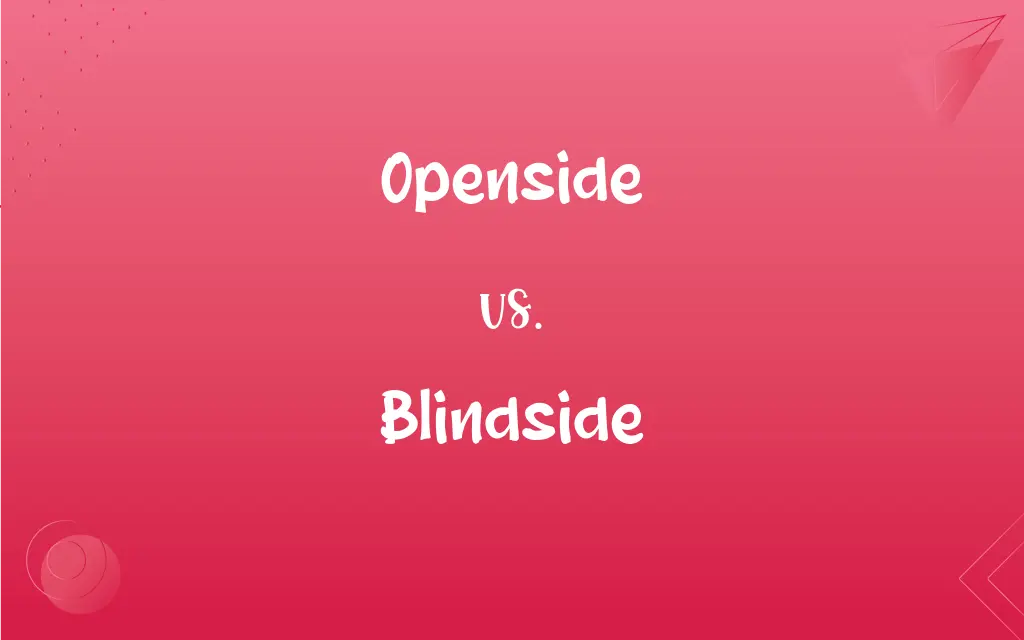Openside vs. Blindside: What's the Difference?
By Aimie Carlson & Janet White || Updated on May 29, 2024
Openside refers to the larger side of the rugby field relative to a scrum or breakdown, while blindside denotes the narrower side closer to the touchline.

Key Differences
Openside in rugby refers to the wider side of the field relative to the location of a scrum or breakdown. This side offers more space and is often used for attacking plays. Openside players, such as the openside flanker, need to be agile and quick to exploit this space and support the backs in open play. Blindside, on the other hand, refers to the narrower side of the field, which is closer to the touchline. This side is typically more constrained in terms of space, making it a more tactical area for defensive maneuvers and short, powerful plays.
The openside flanker generally has a higher work rate around the field, being more involved in open play, while the blindside flanker focuses on securing the ball in tight situations and providing physical presence. Both positions are crucial but require different skill sets and physical attributes to be effective.
Openside play emphasizes speed and agility due to the available space, whereas blindside play emphasizes strength and tactical awareness due to the limited space. These differing requirements shape the roles and responsibilities of the players occupying these positions.
Comparison Chart
Field Position
Wider side of the field
Narrower side, closer to the touchline
Player Role
Agile, quick, supports backs in open play
Strong, robust, focuses on tight, physical play
ADVERTISEMENT
Typical Player
Openside flanker (number 7)
Blindside flanker (number 6)
Play Style
Exploiting space, high work rate
Tactical defense, physical presence
Primary Function
Leading turnovers, supporting in wider channels
Securing ball in tight situations, supporting forwards
Openside and Blindside Definitions
Openside
Crucial for creating offensive opportunities.
Openside plays often lead to breaks and tries.
Blindside
The narrower side of the field relative to a scrum.
The scrum was set near the touchline on the blindside.
ADVERTISEMENT
Openside
Associated with speed and agility.
The openside flanker sprinted to support the backs.
Blindside
Involves securing the ball in tight spaces.
The blindside player was essential in winning the ruck.
Openside
The larger side of the field relative to a scrum.
The team decided to attack down the openside for more space.
Blindside
Key for defensive maneuvers.
Plays on the blindside often involve short, powerful runs.
Openside
Involves supporting open play.
The openside was critical in linking play between forwards and backs.
Blindside
Supports physical aspects of the game.
The blindside's physicality helped dominate the scrums.
Openside
Requires a high work rate.
An effective openside player covers a lot of ground.
Blindside
To hit or attack on or from the blind side.
Openside
(rugby) The space on the side of the pitch with the larger distance between the breakdown/set piece and the touchline.
Blindside
To catch or take unawares, especially with harmful or detrimental results
The news blindsided us.
Openside
(rugby union) openside flanker
The openside packs down at the scrum on the openside.
Blindside
(automotive) A driver's field of blindness around an automobile; the side areas behind the driver.
Blindside
(rail transport) A tram/train driver's field of blindness around a tram (trolley/streetcar) or a train; the side areas behind the tram/train driver.
Blindside
(figurative) A person's weak point.
Blindside
(rugby) The space on the side of the pitch with the shorter distance between the breakdown/set piece and the touchline; compare openside.
Blindside
(rugby union) The blindside flanker, a position in rugby union, usually number 6.
The blindside packs down at the scrum on the blindside.
Blindside
(transitive) To attack (a person) on his or her blind side.
The robbers crept out of the forest and blindsided the traveller.
Blindside
To catch off guard; to take by surprise.
He had completed his plan to develop a new office building, but was blindsided by the sudden drop in real estate values.
Blindside
To attack a person from his blind side; metaphorically, to give a person an unpleasant suprise.
Blindside
Catch unawares, especially with harmful consequences;
The economic downturn blindsided many investors
Blindside
Attack or hit on or from the side where the attacked person's view is obstructed
Blindside
Associated with strength and tactical awareness.
The blindside flanker made a crucial tackle near the touchline.
FAQs
What is the openside in rugby?
The openside is the wider side of the field relative to the position of a scrum or breakdown.
Who plays on the openside?
The openside flanker (number 7) typically plays on the openside.
What skills are required for an openside flanker?
Speed, agility, and a high work rate are crucial for an openside flanker.
What is the primary role of an openside flanker?
To exploit space, support the backs, and lead turnovers.
What skills are needed for a blindside flanker?
Strength, robustness, and tactical awareness are key for a blindside flanker.
Who plays on the blindside?
The blindside flanker (number 6) usually plays on the blindside.
How does the openside affect gameplay?
The openside offers more space, facilitating attacking plays.
What is the blindside in rugby?
The blindside is the narrower side of the field, closer to the touchline.
Does the blindside have less space?
Yes, the blindside typically has less space compared to the openside.
How does the blindside influence strategy?
The blindside is more tactical, focusing on defense and short, powerful plays.
Why is the openside important in rugby?
It provides space for creating offensive opportunities.
Are blindside flankers involved in scrums?
Yes, they support the forwards in scrums and lineouts.
What is the main function of a blindside flanker?
To secure the ball in tight situations and provide physical presence.
Why is the blindside crucial in rugby?
It is essential for defensive tactics and physical dominance.
How does the openside flanker contribute to defense?
By quickly closing down space and supporting in turnovers.
How do openside and blindside differ in attacking play?
Openside focuses on exploiting space, while blindside focuses on physical, tactical plays.
Can the openside change during the game?
Yes, the openside changes with the position of the scrum or breakdown.
What is a typical play on the blindside?
Short, powerful runs and defensive maneuvers.
Are openside and blindside terms used in other sports?
They are primarily used in rugby to describe field positioning.
Do openside flankers have a high work rate?
Yes, they are known for covering a lot of ground during a game.
About Author
Written by
Aimie CarlsonAimie Carlson, holding a master's degree in English literature, is a fervent English language enthusiast. She lends her writing talents to Difference Wiki, a prominent website that specializes in comparisons, offering readers insightful analyses that both captivate and inform.
Co-written by
Janet WhiteJanet White has been an esteemed writer and blogger for Difference Wiki. Holding a Master's degree in Science and Medical Journalism from the prestigious Boston University, she has consistently demonstrated her expertise and passion for her field. When she's not immersed in her work, Janet relishes her time exercising, delving into a good book, and cherishing moments with friends and family.































































